|
Re: PTV's 1951 Packard 200
|
||||
|---|---|---|---|---|
|
Home away from home
|
John - look at this service advisory. Be sure to use steel tubing.
https://www.packardinfo.com/xoops/html/downloads/SC/SC-VOL22NO14.pdf
Posted on: 2016/6/23 16:35
|
|||
|
||||
|
Re: PTV's 1951 Packard 200
|
||||
|---|---|---|---|---|
|
Forum Ambassador
|
I believe that filter plumbing in the 48 memo where the pigtail is removed and oil runs thru the filter before going to the lifter gallery is for pre 51 cars with solid lifters. The filter lowers pressure enough that hydraulic lifters had issues with the oil flowing thru the filter first.
When adding a filter, many of the 48-50 327 blocks, and the 51-4 engines change to a tee fitting at the lower port where the pigtail and sender are fed. One leg off the new tee goes to the input on side of the filter and bottom output of filter drops almost straight down to a port on the side of the block where oil drops directly back into the crankcase. Some of the tees had a restriction or orifice on the filter feed port to slow the flow and others used a restriction at the filter elbow fitting. Some filter canisters have very small holes in the center pipe to control how fast oil can exit and flow back to the crankcase. Both of those control means were to limit how much flow could flow thru the filter so the lifters didn't starve. Here is a snip from one of Kevs photos where almost all the filter plumbing is shown.
Posted on: 2016/6/23 17:02
|
|||
|
Howard
|
||||
|
||||
|
Re: PTV's 1951 Packard 200
|
||||
|---|---|---|---|---|
|
Home away from home
|
That was another question I was wondering about was about an orifice. The "T" has one to each side and one straight thru. The straight thru hole is the largest where the sending unit screws into. The other 2 holes are smaller and both the same size. Should the hole feeding to the lifters have a larger hole than the one to the oil filter?
It looks like the lines would all be made from 1/4" brake line? John Attach file:  (32.13 KB) (32.13 KB)
Posted on: 2016/6/23 18:43
|
|||
|
||||
|
Re: PTV's 1951 Packard 200
|
||||
|---|---|---|---|---|
|
Forum Ambassador
|
I'd go ahead and use the tee as is with one of the smaller side holes to the filter. The orifice was used on the pre and immediate postwar 356 engines with hydraulic lifters and some of the smaller engines with optional lifters. By 51 when hydraulic lifters were more common the flows had been optimized. If you do have a problem with lifter noise then you can address it again. There is a discussion on site somewhere with the orifice size. I think it was .073 but would have to search bulletins to be sure.
1/4 steel premade lengths of brake tubing works fine although the color on most you find in stores is dark gray instead of the brighter galvanized color. Comes with two different sized nuts and flared ends. One nut is short like Packard used and since you will probably have to cut and flare the other end to length you can buy extra short nuts if you don't like the long ones.
Posted on: 2016/6/23 20:15
|
|||
|
Howard
|
||||
|
||||
|
Re: PTV's 1951 Packard 200
|
||||
|---|---|---|---|---|
|
Home away from home
|
One good thing I don't believe my engine has hydraulic lifter. Seems few 288 came with them.
John
Posted on: 2016/6/23 20:30
|
|||
|
||||
|
Re: PTV's 1951 Packard 200
|
||||
|---|---|---|---|---|
|
Home away from home

|
If I remember correctly your engine number would have an H at the end of the number if it had hydraulic lifters. My 288 with hydraulic lifters is tarped up otherwise I would confirm that for you. I'm sure it's in my ' 51 blog.
Posted on: 2016/6/24 20:19
|
|||
|
[url=h
|
||||
|
||||
|
Re: PTV's 1951 Packard 200
|
||||
|---|---|---|---|---|
|
Home away from home

|
Any updates on your progress?
Posted on: 2016/9/19 20:42
|
|||
|
[url=h
|
||||
|
||||
|
Re: PTV's 1951 Packard 200
|
||||
|---|---|---|---|---|
|
Home away from home
|
No not much new to report here. Other things keep getting in the way. Doesn't seem as small as the lines coming and going to the oil filter, much oil would flow to the filter.
Did pickup a few tidbits. Found a replacement B pillar trim piece, Picked up a set of power steering pulleys for possible future use. And the cover for the Ultramatic converter housing. And a spare wheel for use as a spare. Still need a replacement driver's side tail light lens. John
Posted on: 2016/9/19 21:00
|
|||
|
||||
|
Re: PTV's 1951 Packard 200
|
||||
|---|---|---|---|---|
|
Forum Ambassador
|
Quote:
Doesn't seem as small as the lines coming and going to the oil filter, much oil would flow to the filter. I believe the figure I read for the amount of oil going to the bypass filter is roughly 10% of the amount available at the connection port. There are restrictions either in the fittings or inside the filter to prevent much more than that from flowing. You don't want too much diverted otherwise the pressure to hydraulic lifters is lowered and they start to clatter. The 1/4" tubing is more than adequate for that amount. Just leave the lid of the canister loose once and you will be amazed at how much the tube lets flow. 
Posted on: 2016/9/19 21:14
|
|||
|
Howard
|
||||
|
||||









